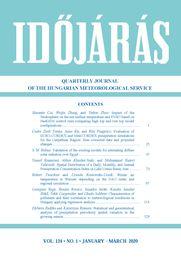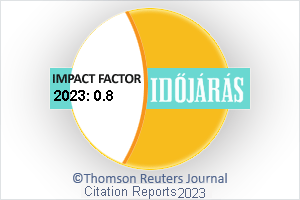Időjárás - Quarterly Journal of the Hungarian Meteorological Service (OMSZ)
Vol. 124, No. 1 * Pages 1–141 * January - March 2020
 |
|
 download [pdf: 24504 KB]
download [pdf: 24504 KB]
Impact of the stratosphere on the sea surface temperature and ENSO based on HadGEM control runs comparing high top and low top model configurations
Shaomin Cai, Weijia Zhang, and Yizhou Zhao
DOI:10.28974/idojaras.2020.1.1 (pp. 1–23)
Shaomin Cai, Weijia Zhang, and Yizhou Zhao
DOI:10.28974/idojaras.2020.1.1 (pp. 1–23)
Evaluation of EURO-CORDEX and Med-CORDEX precipitation simulations for the Carpathian Region: Bias corrected data and projected changes
Csaba Zsolt Torma, Anna Kis, and Rita Pongrácz
DOI:10.28974/idojaras.2020.1.2 (p. 25–)
Csaba Zsolt Torma, Anna Kis, and Rita Pongrácz
DOI:10.28974/idojaras.2020.1.2 (p. 25–)
Validation of the existing models for estimating diffuse solar radiation over Egypt
S. M. Robaa
DOI:10.28974/idojaras.2020.1.3 (p. 47–)
S. M. Robaa
DOI:10.28974/idojaras.2020.1.3 (p. 47–)
Spatial distribution of the daily, monthly, and annual precipitation concentration indices in the Lake Urmia basin, Iran
Yousef Ramezani, Abbas Khashei-Siuki, and Mohammad Nazeri Tahroudi
DOI:10.28974/idojaras.2020.1.4 (p. 73–)
Yousef Ramezani, Abbas Khashei-Siuki, and Mohammad Nazeri Tahroudi
DOI:10.28974/idojaras.2020.1.4 (p. 73–)
Winter air temperature in Warsaw depending on the NAO index and the regional circulation
Robert Twardosz and Urszula Kossowska-Cezak
DOI:10.28974/idojaras.2020.1.5 (p. 97–)
Robert Twardosz and Urszula Kossowska-Cezak
DOI:10.28974/idojaras.2020.1.5 (p. 97–)
Characteristics of pollutants and their correlation to meteorological conditions in Hungary applying regression analysis
Georgina Nagy, Renáta Kovács, Szandra Szőke, Katalin Antalné Bökfi, Tekle Gurgenidze, and Ghada Sahbeni
DOI:10.28974/idojaras.2020.1.6 (p. 113–)
Georgina Nagy, Renáta Kovács, Szandra Szőke, Katalin Antalné Bökfi, Tekle Gurgenidze, and Ghada Sahbeni
DOI:10.28974/idojaras.2020.1.6 (p. 113–)
Statistical and geostatistical analysis of spatial variation of precipitation periodicity in the growing season
Elżbieta Radzka and Katarzyna Rymuza
DOI:10.28974/idojaras.2020.1.7 (pp. 129–141)
Elżbieta Radzka and Katarzyna Rymuza
DOI:10.28974/idojaras.2020.1.7 (pp. 129–141)
IDŐJÁRÁS - Quarterly Journal

Az IDŐJÁRÁS a HungaroMet Nonprofit Zrt. negyedévenként megjelenő angol nyelvű folyóirata
Megrendelhető a journal.idojaras@met.hu címen.
A szerzőknek szánt útmutató itt olvasható.
Megrendelhető a journal.idojaras@met.hu címen.
A szerzőknek szánt útmutató itt olvasható.









